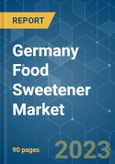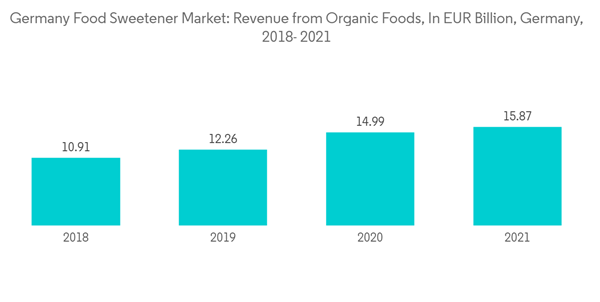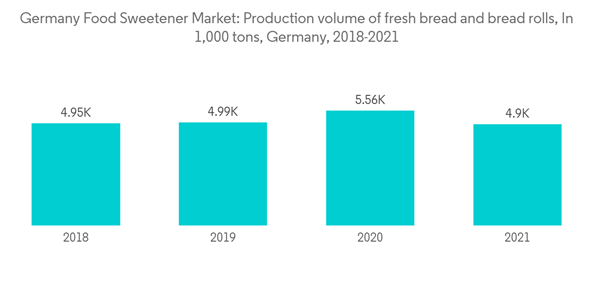In Europe, Germany is the largest market for food sweeteners. An increase in the consumption of processed food products is driving the market’s growth. The widespread adoption of food sweeteners across the food and beverage (F&B) sector can be attributed to the increasing demand for low-sugar and calorie consumer goods, such as diet coke, yogurt, ice cream, and grain-based desserts, which is one of the key factors driving the market’s growth. The rising health consciousness and the increasing prevalence of obesity, diabetes, cardiovascular diseases, and other lifestyle-based ailments across the country further support this growth. The demand for processed and packaged food is increasing in both developed and developing regions of the world due to rising urbanization, a growing middle-class population, an increase in the number of working women, and rising disposable incomes. This trend may lead to an increase in the demand for food packaging and sugar processing solutions, which may fuel the demand for high-fructose corn syrup in food and beverage applications in Germany.
The introduction of natural sweeteners composed of organic ingredients, such as stevia and honey, to imitate conventional sugar's taste is another growth-inducing factor. Manufacturers are focusing on expanding their portfolios by including artificial and other sugar substitutes, such as xylitol, erythritol, and mannitol, in the formulation of confectionery items, which is supporting the market’s growth significantly. Other factors, such as strategic collaborations among key players and rising investments in R&D activities, create a positive outlook for the German food sweetener market.
Germany Food Sweetener Market Trends
Stevia is the Largest and the Fastest-growing Segment
German customers are increasingly sensitive toward choosing healthy and sustainable nutrition. The food and beverage industry is Germany's 4th largest industry sector, as per Germany Trade and Invest. Multiple factors, such as the rising demand for healthier foods, influence consumer trends in the health and wellness market. In Germany, more than 100 companies are manufacturing products that contain steviol glycosides. All these companies use stevia to promote the sweetening effect of food additives. The bulk sweetener market is predicted to experience a very slow growth rate in Germany due to the replacement of these bulk sweeteners with natural and low-calorie sweeteners like stevia. This trend is due to the approval by both the US and European regulators for the use of stevia sweeteners, and the demand for stevia leaf is skyrocketing. Some of the key players in the market, like Cargill Inc., Ingredion Incorporated, and Organic Stevia GmbH, hold a major share of the German stevia market. The stevia plant is far more expensive than artificial sweeteners, including aspartame, saccharin, and sucralose, which restrains the stevia market.Shift Toward Convenience and Processed Food Consumption
One of the key drivers propelling the expansion of the food sweeteners, such as high-fructose corn syrup, is the rising demand for convenience and processed goods, such as sweet/sugar-based ready-to-eat foods, ready-to-drink beverages, snacks, and frozen dinners. The country is experiencing an increased demand for processed and packaged food, which may increase the need for food packaging and sugar processing solutions, driving the demand for food sweeteners in food and beverage applications. This increase in demand is attributed to factors such as rising urbanization, a growing middle-class population, an increase in the number of working women, and rising disposable income. For instance, according to Statistisches Bundesamt, in 2021, around 79% of men and 72% of women were employed in Germany. According to BMEL, in 2022, approximately 21% of German consumers always paid attention to the sugar content in processed and convenience foods when shopping.The increased health consciousness of consumers in Germany is a significant factor driving the market for food sweeteners. The sector is also rising due to consumers' increasing preference for natural products. The market for these industries is also driven by fast food, bakery, consumer lifestyle, and eating habits, which has led to the industry witnessing significant growth throughout the projected period. Consumer awareness campaigns, regulations requiring less sugar consumption, and their inclusion in a variety of marketable health and wellness food products are contributing to the rapid increase in the use of sugar substitutes, like xylitol, erythritol, and mannitol, due to their wide application in food and beverage applications.
Germany Food Sweetener Industry Overview
Germany’s sweetener market is fragmented, and acquisitions, new product launches, joint ventures, and expansion are the most preferred growth strategies of market players. The major players in the market are Cargill Inc., Tate & Lyle, Organic Stevia GmbH, and Ingredion Incorporated.Additional Benefits:
- The market estimate (ME) sheet in Excel format
- 3 months of analyst support
This product will be delivered within 2 business days.
Table of Contents
Companies Mentioned (Partial List)
A selection of companies mentioned in this report includes, but is not limited to:
- Nordzucker AG
- Archer Daniels Midland Company
- Cargill Incorporated
- Tate & Lyle
- Organic Stevia GmbH
- Denk Ingredients
- Stevialine GmbH & Co. KG
- Roquette Frères
- DuPont
- Associated British Food PLC
- Ingredion Incorporated










